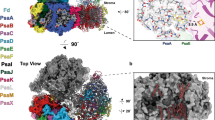Abstract
Photosystems I and II (PSI and II) are reaction centres that capture light energy in order to drive oxygenic photosynthesis; however, they can only do so by interacting with the multisubunit cytochrome b6f complex. This complex receives electrons from PSII and passes them to PSI, pumping protons across the membrane and powering the Q-cycle. Unlike the mitochondrial and bacterial homologue cytochrome bc1, cytochrome b6f can switch to a cyclic mode of electron transfer around PSI using an unknown pathway. Here we present the X-ray structure at 3.1 Å of cytochrome b6f from the alga Chlamydomonas reinhardtii. The structure bears similarities to cytochrome bc1 but also exhibits some unique features, such as binding chlorophyll, β-carotene and an unexpected haem sharing a quinone site. This haem is atypical as it is covalently bound by one thioether linkage and has no axial amino acid ligand. This haem may be the missing link in oxygenic photosynthesis.
This is a preview of subscription content, access via your institution
Access options
Subscribe to this journal
Receive 51 print issues and online access
$199.00 per year
only $3.90 per issue
Buy this article
- Purchase on Springer Link
- Instant access to full article PDF
Prices may be subject to local taxes which are calculated during checkout





Similar content being viewed by others
References
Mitchell, P. Possible molecular mechanisms of the protomotive function of cytochrome systems. J. Theor. Biol. 62, 327–367 (1976)
Crofts, A. & Wraight, C. A. The electrochemical domain of photosynthesis. Biochim. Biophys. Acta 726, 149–185 (1983)
Sazanov, L. A., Burrows, P. A. & Nixon, P. J. The plastid ndh genes code for an NADH-specific dehydrogenase: isolation of a complex I analogue from pea thylakoid membranes. Proc. Natl Acad. Sci. USA 95, 1319–1324 (1998)
Zhang, H., Whitelegge, J. P. & Cramer, W. A. Ferredoxin:NADP+ oxidoreductase is a subunit of the chloroplast cytochrome b6f complex. J. Biol. Chem. 276, 38159–38165 (2001)
Lavergne, J. Membrane potential-dependant reduction of cytochrome b6 in an algal mutant lacking photosystem I centers. Biochim. Biophys. Acta 725, 25–33 (1983)
Joliot, P. & Joliot, A. The low potential electron transfer chain in cytochrome b/f complex. Biochim. Biophys. Acta 933, 319–333 (1988)
Depege, N., Bellafiore, S. & Rochaix, J.-D. Role of chloroplast protein kinase Stt7 in LHCII phosphorylation and state transition in Chlamydomonas. Science 299, 1572–1575 (2003)
Wollman, F.-A. State transitions reveal the dynamics and flexibility of the photosynthetic apparatus. EMBO J. 20, 3623–3630 (2001)
Joliot, P. & Joliot, A. In vivo analysis of the effect of dicyclohexylcarbodiimide on electron and proton transfers in cytochrome bf complex of Chlorella sorokiniana. Biochemistry 37, 10404–10410 (1998)
Pierre, Y. et al. On the presence and role of a molecule of chlorophyll a in the cytochrome b6f complex. J. Biol. Chem. 272, 21901–21908 (1997)
Xia, D. et al. Crystal structure of the cytochrome bc1 complex from bovine heart mitochondria. Science 277, 60–66 (1997)
Zhang, Z. et al. Electron transfer by domain movement in cytochrome bc1 . Nature 392, 677–684 (1998)
Iwata, S. et al. Complete structure of the 11-subunit bovine mitochondrial cytochrome bc1 complex. Science 281, 64–71 (1998)
Hunte, C., Koepke, J., Lange, C., Rossmanith, T. & Michel, H. Structure at 2.3 Å resolution of the cytochrome bc1 complex from the yeast Saccharomyces cerevisiae co-crystallized with an antibody Fv fragment. Struct. Fold Des. 8, 669–684 (2000)
Breyton, C., Tribet, C., Olive, J., Dubacq, J.-P. & Popot, J.-L. Dimer to monomer conversion of the cytochrome b6f complex. Causes and consequences. J. Biol. Chem. 272, 21892–21900 (1997)
Pierre, Y., Breyton, C., Kramer, D. & Popot, J.-L. Purification and characterization of the cytochrome b6f complex from Chlamydomonas reinhardtii. J. Biol. Chem. 270, 29342–29349 (1995)
Zhang, H., Kurisu, G., Smith, J. L. & Cramer, W. A. A defined protein-detergent-lipid complex for crystallization of integral membrane proteins: The cytochrome b6f complex of oxygenic photosynthesis. Proc. Natl Acad. Sci. USA 100, 5160–5163 (2003)
Breyton, C. The cytochrome b6f complex: structural studies and comparison with the bc1 complex. Biochim. Biophys. Acta 1459, 467–474 (2000)
Martinez, S. E., Huang, D., Szczepaniak, A., Cramer, W. A. & Smith, J. L. Crystal structure of chloroplast cytochrome f reveals a novel cytochrome fold and unexpected heme ligation. Structure 2, 95–105 (1994)
Darrouzet, E., Moser, C. C., Dutton, P. L. & Daldal, F. Large scale domain movement in cytochrome bc1: a new device for electron transfer in proteins. Trends Biochem. Sci. 26, 445–451 (2001)
Carrell, C. J., Zhang, H., Cramer, W. A. & Smith, J. L. Biological identity and diversity in photosynthesis and respiration: structure of the lumen-side domain of the chloroplast Rieske protein. Structure 5, 1613–1625 (1997)
Lange, C., Nett, J. H., Trumpower, B. L. & Hunte, C. Specific roles of protein-phospholipid interactions in the yeast cytochrome bc1 complex structure. EMBO J. 20, 6591–6600 (2001)
Zhang, H., Huang, D. & Cramer, W. A. Stoichiometrically bound β-carotene in the cytochrome b6f complex of oxygenic photosynthesis protects against oxygen damage. J. Biol. Chem. 274, 1581–1587 (1999)
Yan, J., Liu, Y., Mao, D., Li, L. & Kuang, T. The presence of 9-cis-β-carotene in cytochrome b6f complex from spinach. Biochim. Biophys. Acta 1506, 182–188 (2001)
Peterman, E. J. et al. Fluorescence and absorption spectroscopy of the weakly fluorescent chlorophyll a in cytochrome b6f of Synechocystis PCC6803. Biophys. J. 75, 389–398 (1998)
Hart, S. E., Schlarb-Ridley, B. G., Delon, C., Bendall, D. S. & Howe, C. J. Role of charges on cytochrome f from the cyanobacterium Phormidium laminosum in its interaction with plastocyanin. Biochemistry 42, 4829–4836 (2003)
Choquet, Y., Zito, F., Wostrikoff, K. & Wollman, F.-A. Cytochrome f translation in Chlamydomonas chloroplast is autoregulated by its carboxyl-terminal domain. Plant Cell 15, 1443–1454 (2003)
Crofts, A. R. et al. Pathways for proton release during ubihydroquinone oxidation by the bc1 complex. Proc. Natl Acad. Sci. USA 96, 10021–10026 (1999)
Zito, F., Finazzi, G., Joliot, P. & Wollman, F.-A. Glu78, from the conserved PEWY sequence of subunit IV, has a key function in cytochrome b6f turnover. Biochemistry 37, 10395–10403 (1998)
Finazzi, G. Redox-coupled proton pumping activity in cytochrome b6f, as evidenced by the pH dependence of electron transfer in whole cells of Chlamydomonas reinhardtii. Biochemistry 41, 7475–7482 (2002)
Mukai, K. et al. An atypical heme-binding structure of cytochrome c1 of Euglena gracilis mitochondrial complex III. Eur. J. Biochem. 178, 649–656 (1989)
Berry, E. A. & Trumpower, B. L. Simultaneous determination of hemes a, b, and c from pyridine hemochrome spectra. Anal. Biochem. 161, 1–15 (1987)
Hurt, E. & Hauska, G. A cytochrome f/b6 complex of five polypeptides with plastoquinol-plastocyanin-oxidoreductase activity from spinach chloroplasts. Eur. J. Biochem. 117, 591–595 (1981)
Whitelegge, J. P., Zhang, H., Aguilera, R., Taylor, R. M. & Cramer, W. A. Full subunit coverage liquid chromatography electrospray ionization mass spectrometry (LCMS+) of an oligomeric membrane protein: cytochrome b6f complex from spinach and the cyanobacterium Mastigocladus laminosus. Mol. Cell Proteom. 1, 816–827 (2002)
Kuras, R. et al. Molecular genetic identification of a pathway for heme binding to cytochrome b6 . J. Biol. Chem. 272, 32427–32435 (1997)
Pond, A. E. et al. Assignment of the heme axial ligand(s) for the ferric myoglobin (H93G) and heme oxygenase (H25A) cavity mutants as oxygen donors using magnetic circular dichroism. Biochemistry 38, 7601–7608 (1999)
Hirst, J. et al. Replacement of the axial histidine ligand with imidazole in cytochrome c peroxidase. 2. Effects on heme coordination and function. Biochemistry 40, 1274–1283 (2001)
Schoepp, B., Chabaud, E., Breyton, C., Vermeglio, A. & Popot, J.-L. On the spatial organization of hemes and chlorophyll in cytochrome b6f. A linear and circular dichroism study. J. Biol. Chem. 275, 5275–5283 (2000)
Nitschke, W. & Hauska, G. On the nature of the g = 6 EPR signal in isolated cytochrome b6f complex from spinach chloroplasts. Biochim. Biophys. Acta 892, 314–319 (1987)
Yu, J. & Le Brun, N. E. Studies of the cytochrome subunits of menaquinone:cytochrome c reductase (bc complex) of Bacillus subtilis. Evidence for the covalent attachment of heme to the cytochrome b subunit. J. Biol. Chem. 273, 8860–8866 (1998)
Schütz, M. et al. Early evolution of cytochrome bc complexes. J. Mol. Biol. 300, 663–675 (2000)
Hope, A. B. The chloroplast cytochrome bf complex: a critical focus on function. Biochim. Biophys. Acta 1143, 1–22 (1993)
Kurisu, G., Zhang, H., Smith, J. L. & Cramer, W. A. Structure of the cytochrome b6f complex of oxygenic photosynthesis: Tuning the cavity. Science, 2 October 2003 (doi:10.1126/science.1090165).
Höffle, G., Kunze, B., Zorzin, C. & Reichenbach, H. Antibiotica aus gleitende Bakterien XIII:Stigmatellin A und B—zwei neue Antibiotika aus Stigmatella aurantiaca (Myxobacterales). Liebigs Annal. Chem. 12, 1883–1904 (1984)
The CCP4 suite: Programs for protein crystallography. Acta Crystallogr. D 50, 760–763 (1994)
Sainz, G. et al. Interruption of the internal water chain of cytochrome f impairs photosynthetic function. Biochemistry 39, 9164–9173 (2000)
Jones, T. A., Zou, J. Y., Cowan, S. W. & Kjeldgaard, M. Improved methods for building protein models in electron density maps and the location of errors in these models. Acta Crystallogr. A 47, 110–119 (1991)
Brünger, A. T. et al. Crystallography & NMR system: A new software suite for macromolecular structure determination. Acta Crystallogr. D 54, 905–921 (1998)
Kraulis, P. J. A program to produce both detailed and schematic plots of protein structures. J. Appl. Crystallogr. 24, 946–950 (1991)
Merritt, E. & Bacon, D. Raster3D photorealistic molecular graphics. Methods Enzymol. 277, 505–524 (1997)
Murakami, S. & Packer, L. Protonation and chloroplast membrane structure. J. Cell Biol. 47, 332–351 (1970)
Acknowledgements
We thank the local contacts of beamline BM30 (ESRF, CRG FIP) J.-L. Ferrer, R. Kahn and P. Carpentier for assistance in data collection; C. Lebreton for membrane preparations; P. Hervé and P. Fellmann for the synthesis of TDS; Y. Pierre, F. Zito and C. Breyton for biochemical expertise; P. Joliot, J. Lavergne, F. Daldal, F. Baymann, W. Nitschke and G. Ajlani for discussions; and C. Breyton, G. Finazzi and A. A. Pascal for discussions and critical reading of the manuscript. This work was supported by the CNRS and Paris-7 University.
Author information
Authors and Affiliations
Corresponding authors
Ethics declarations
Competing interests
The authors declare that they have no competing financial interests.
Supplementary information
Rights and permissions
About this article
Cite this article
Stroebel, D., Choquet, Y., Popot, JL. et al. An atypical haem in the cytochrome b6f complex. Nature 426, 413–418 (2003). https://doi.org/10.1038/nature02155
Received:
Accepted:
Issue Date:
DOI: https://doi.org/10.1038/nature02155
This article is cited by
-
The cytochrome b6f complex: plastoquinol oxidation and regulation of electron transport in chloroplasts
Photosynthesis Research (2024)
-
Fatty acid desaturases (FADs) modulate multiple lipid metabolism pathways to improve plant resistance
Molecular Biology Reports (2022)
-
Dynamic changes in membrane lipid composition of leaves of winter wheat seedlings in response to PEG-induced water stress
BMC Plant Biology (2020)
-
Optimal efficiency of the Q-cycle mechanism around physiological temperatures from an open quantum systems approach
Scientific Reports (2019)
Comments
By submitting a comment you agree to abide by our Terms and Community Guidelines. If you find something abusive or that does not comply with our terms or guidelines please flag it as inappropriate.



